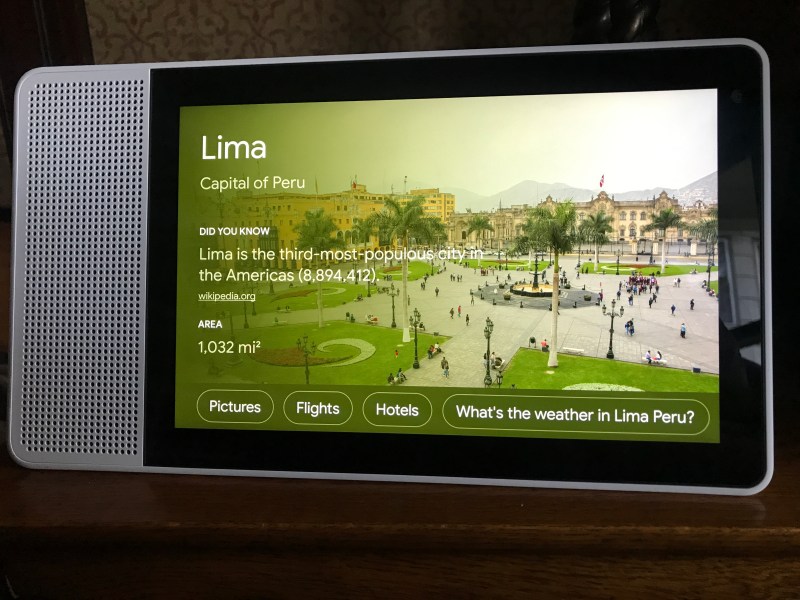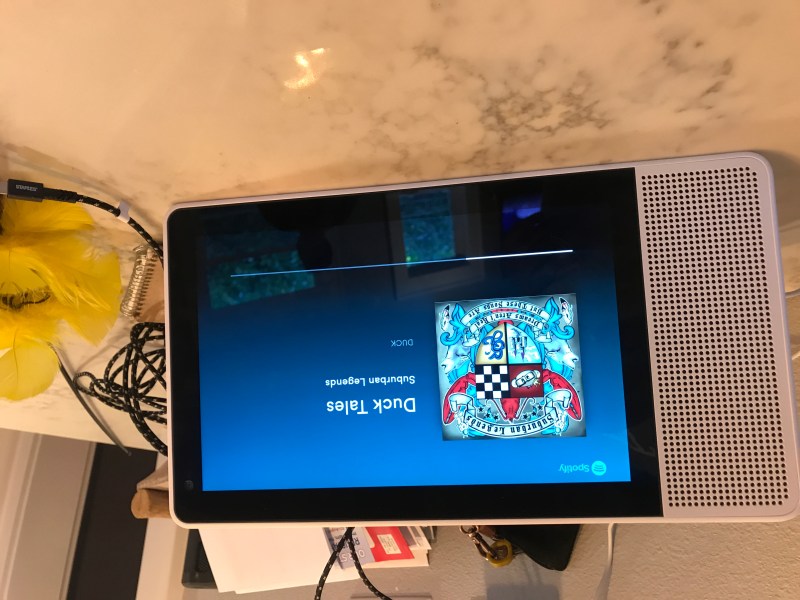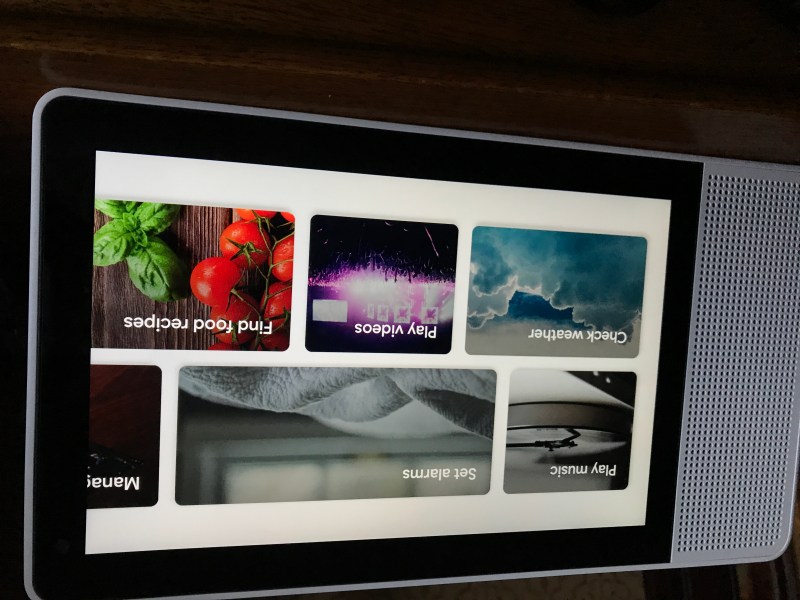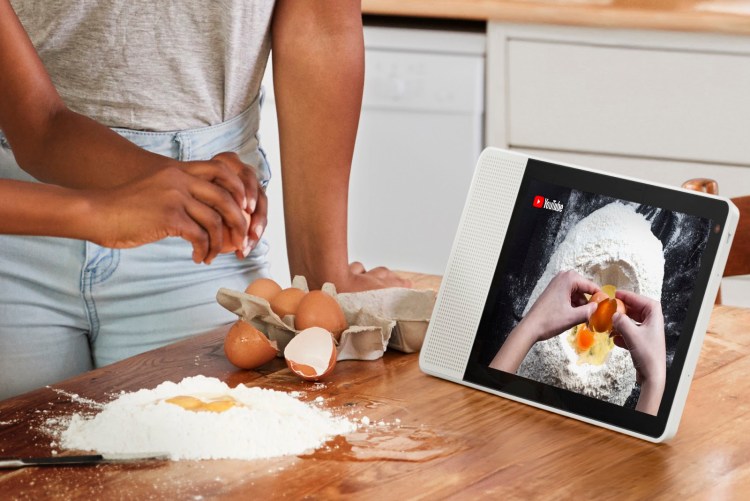testsetset
Google Assistant has spread over the past year or so from Home smart speakers with no visual aid to Android smartphones, televisions, tablets, the Google Assistant iOS app for iPhone and iPad, and more.
Now comes the Lenovo Smart Display, the first smart speaker with a screen and Google Assistant inside to hit the market. Google first introduced smart displays at the Consumer Electronics Show in January, and more from LG, Sony, and JBL are due out later this year.
The Smart Display takes advantage of all the ways Google Assistant acts differently when operating on a device with a display. This includes the ability to do things like share memories from Google Photos or completely change the way you search the web or watch YouTube, but all devices with Google Assistant and a screen do not operate the same.
The 8-inch and 10-inch Lenovo Smart Display units go on sale today for $199 and $249, respectively.
June 5th: The AI Audit in NYC
Join us next week in NYC to engage with top executive leaders, delving into strategies for auditing AI models to ensure fairness, optimal performance, and ethical compliance across diverse organizations. Secure your attendance for this exclusive invite-only event.
Here are some first thoughts on the performance of essential features for the Lenovo Smart Display.
Video
Being able to say “Show me cat brain freeze videos on YouTube” or whatever else you want to watch is a key differentiator for the Smart Display over Amazon’s Echo Show. The latter’s issues in this area first began last fall and continued in December when a dispute over Google’s Nest being sold on Amazon’s marketplace spilled over into the visual smart speaker market. Just a few months after the release of the Echo Show, the ability to search for YouTube videos with your voice was removed from the device.
That feature is now a main selling point of Lenovo’s Smart Display and will be for the smart speakers with a screen and Google Assistant due out later this year from Sony, JBL, and LG.
If you’ve got the $40-a-month YouTube TV, you can also say “OK Google, play ABC on YouTube TV” to watch live television, or you can ask Google to replay your favorite shows.
The smart display isn’t able to work with Netflix, which may be off-putting for some, and is a downside for any kids factored into the equation, but personally I’d rather watch a movie or favorite TV show on something larger than a 10-inch screen.
Search
Search performance can serve up snippets of text and audio results, as well as imagery, which can be really helpful if you have a curious kid in the house with lots of questions. Unlike Home speakers, any query brings up smart suggestions, which are recommended follow-up questions that surface at the bottom of the screen so you can dive down a rabbit hole of information anytime a question arises.
Predictive AI like smart suggestions is deployed on a range of Google services ranging from the new Gmail to chat app Allo and various search engines.
Smart suggestions on Smart Display are useful when asking questions and also come in handy when looking at upcoming calendar events, where you will see suggestions to create a new event or reminder.
Being able to visualize Google Translate is also more helpful than hearing a translation served up by a Home smart speaker.

General Google search is also improved. Ask for more information about a city, for example, and you will get full-screen images for results, with suggested follow-ups that allow you to dive down a rabbit hole of information on a subject. For visual search, say things like “What does San Francisco look like?” to get a range of cool photos to sift through.
Search for nearby bakeries and you can be shown relevant listings and given the option to read their reviews and see ratings between 0 and 5 stars, store hours, listing photos, and other information. Once you select a bakery, you can ask Google to make a phone call to the business.
This makes the experience of interacting with local businesses more flexible and is more interesting than having the same question answered by a Home speaker. It could become a lot more helpful should experimental AI Duplex ever be introduced for the broader Google Assistant user community to make reservations and appointments.
Unlike search on any tablet or other surface, the Smart Display has no keyboard option, just voice and touch interaction.
Music, news, and podcasts
The Lenovo Smart Display has two passive tweeters on the left side that allow it to generate some rich sound, but the output seems less than you would get with a Google Home or Amazon Echo at half the price.
Compared to a Home speaker or Echo, you can hear that the Smart Display delivers audio from a single direction instead of the omnidirectional sound experience delivered by cylindrical speakers.
While there are absolute advantages to interacting with an AI assistant through a dedicated screen, audiophiles may be happier with a new Sonos Beam or pair of Echo or Google Home speakers.
On another note, a display made to operate as a touchscreen smart speaker should not only provide good audio, it should also take advantage of the touchscreen. In that vein, music recommendations below what I’m listening to would be a great addition. Right now, listening to music with Smart Display is essentially the same as asking Google Assistant to Cast music on a television.

Some form of additional content recommendation could be on the way.
The visual snapshot feature with Google Assistant was introduced for Android phones and the Assistant iOS app earlier this month and provides a visual experience akin to some of the daily rundown-like visuals provided by the Smart Display — like your calendar and reminders. It also delivers voice app recommendations and will include podcast recommendations in the future, a company spokesperson told VentureBeat recently.
That would fit with the walled garden approach taken by the Smart Display. Ask for any podcast episode today and it will be shared by Google Podcasts, an app that made its debut in the Google Play store last month. Other popular podcast streaming services, like TuneIn and iHeartRadio, can play radio stations, but podcasts from these streaming services won’t work.
The entire news experience on a device like the Smart Display appears to be a work in progress.
Ask a Home speaker “What’s in the news?” and it will give you podcasts or audio updates. The Smart Display will serve up those same recommendations — despite the fact that it has a screen.
Say “Show me the latest news headlines,” and you still get podcasts instead of what you asked for: news headlines.
If you say, “Show me the latest sports news” on a smartphone, for example, you get a carousel of news articles. Say the same to a Smart Display and you will get podcasts by default.
The Smart Display doesn’t even include video in news updates when you say “Show me the news,” but that’s not to say there’s no news video available. Say, “Play me business news video” and you’ll get CNBC video. Google Assistant does not yet respond to “Play local news video,” which is a major miss in my book.
Design
Design-wise, the Smart Display has an interesting form factor that looks like a tablet jutting out from a set of speakers fused to a base, which holds the majority of the device’s weight.
Compared to the 7-inch screen from Smart Display’s chief competitor, the Echo Show , the Lenovo’s 8-inch or 10-inch screens with HD display provide a larger, prettier surface for interaction with Google Assistant.
Overall, with its lighter color and bamboo back, Lenovo Smart Display seems to me to be a more attractive addition to a kitchen than the Echo Show.
When attached to Google Photos, the Smart Display makes a great digital photo frame, especially if you choose to create a common album to share with family or friends.
Another big plus is that the Smart Display automatically adjusts at night, turning down its brightness and displaying only a clock when you turn off the lights in a room.
And if you’re a bit paranoid about being spied on, the camera on the front comes with a button that you can slide a piece of plastic in front of. Oddly, the camera-blocking piece of plastic has a red dot on it that resembles the red dot typically seen when recording video.
The microphone can also be muted for times when you don’t want Google Assistant listening to anything, just like on Home speakers.
These might seem like small features, but privacy is a major impediment for some people considering the purchase of a smart speaker, according to a survey by PricewaterhouseCooper conducted earlier this year.
Calls
Voice Match, Google’s voice identification service, trips up sometimes and has difficulty making phone calls. Once that’s out of the way, it can work great. Unfortunately, it’s locked into Duo, the less-popular video chat service from Google’s confusing basket of apps.
Google’s approach closely mimics the way Amazon’s Echo speakers Drop In video calls.
The Lenovo Smart Display is only available in horizontal mode, that is unless you want to make video calls, which you can do in vertical mode.
Additional ways to use a Smart Display propped up in a vertical way will be made available in the future, a Lenovo spokesperson told VentureBeat in an email.
Hits and misses
Like Home speakers, Smart Display can carry out multiple tasks at once in Routines; set timers; and, when enabled with the Home app, respond to follow-up questions.
Unlike Home speakers, if you ask for interesting random trivia — like the fact that ice skates used to use animal bone instead of metal — results now come with images.
The ability to adjust a timer or control smart home appliances is a plus, but you can do the same with the Google Assistant app or Google Assistant on most Android smartphones.
Perhaps the most frustrating part of using a Smart Display is that if you fail to respond within about 10 seconds when, for example, asking to see listings of local bakeries, what you’re doing will disappear and the only way to get it back is to ask the same question again.
There’s no way to change time settings or turn this timeout feature off, a Lenovo spokesperson told VentureBeat, but it does not impact video playback, Duo calling, or step-by-step cooking instructions.
The Google Assistant experience on the Lenovo Smart Display would benefit from the My Activity feature for tracking your history with the AI assistant, or some other way to recall recent interactions.
Two key missing features:
- Lens, Google Assistant’s computer vision service, is not available on the Smart Display. Lens is helpful today when on a mobile device but if made available in Smart Display for things like the recently introduced Style Match could be a competitor with Amazon’s Echo Look fashion assistant. A Google spokesperson declined to comment on when Lens may be extended to smart displays.
- Surprisingly, the Lenovo Smart Display is unable to take pictures or record video. Pixel smartphones can respond to “OK Google, take a selfie,” but Google Assistant on the Smart Display can’t take a selfie or any other kind of photo. I don’t really need this device to record my every move, but when you consider home range robots like General Electric’s Jibo can record photos and videos of your cooking, the inability to take pictures seems like a strange oversight.
One thing I do enjoy about Smart Display is the visual group of tiles indicating what Google Assistant can do. As simple as this may seem, it’s important, since one of the biggest issues people encounter with AI assistants is not knowing the broad range of things the assistant is able to do.

Another major feature that sets Smart Display apart from the Google Assistant experience in Home speakers, or basically any other form factor, is how much better it is to have Google as a cooking companion.
Just ask for recipes and you’ll get a list of choices from Betty Crocker, Food Network, and other popular destinations on the web. Once you make a selection, you will be walked through the same list of prompts available with a Home speaker, but your list of ingredients and next steps are visually displayed on a screen. It is a lot easier to follow along and you can swipe the screen if you choose instead of having to say “Next ingredient” for step-by-step instructions. Repeating “OK Google, next ingredient” can be just fine when you say it a few times but is obviously not the best choice when you have to say it a dozen times or more.

Though this represents an important change to the Google Assistant cooking experience, there is a seminal flaw here when compared to chief competitor Alexa. By comparison, Alexa on Echo Show devices is able to play instructional video from Food Network and Allrecipes.
By comparison, the Food Network Google Assistant voice app only gives you the lame option to email yourself a link to a recipe.
Both Google and Amazon have flexed their cooking prowess for more than a year. That’s because previous figures shared by Amazon found that more than 50 percent of all Echo speakers were used in the kitchen.
YouTube can, of course, serve up plenty of instructional cooking videos, but the inability to give people instructional videos alongside step-by-step instructions seems like a critical miss.
Conclusion
My first impression is that the Lenovo Smart Display provides a variety of attractive features that on their own make the device a welcome addition to any bedroom or kitchen. These include suggestions with Google search and the ability to command YouTube and Google Photos.
If you don’t mind being locked into Google’s porous walled garden, then this is a great device. If that’s an issue for you or you’re an audiophile, the Lenovo Smart Display may not be right for you.


